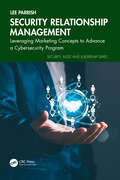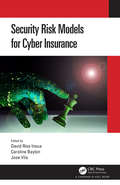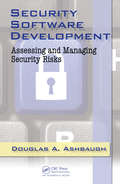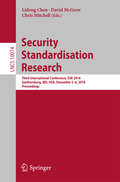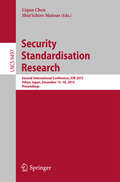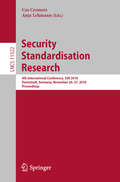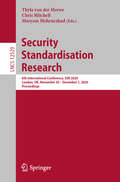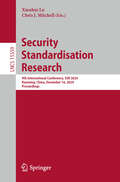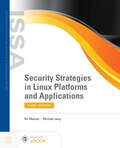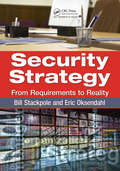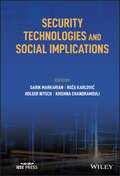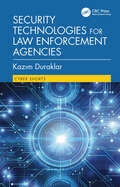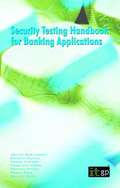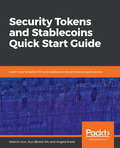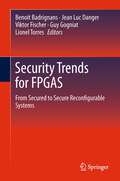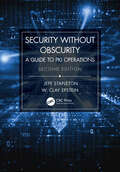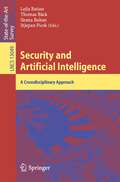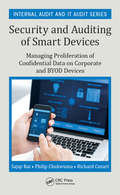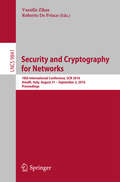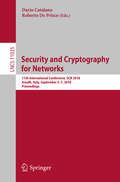- Table View
- List View
Security Relationship Management: Leveraging Marketing Concepts to Advance a Cybersecurity Program (Security, Audit and Leadership Series)
by Lee ParrishAligning information security to the goals and strategies of the business is paramount for ensuring risks are addressed, without an abundance of negative impacts to the company. But how does a Chief Information Security Officer (CISO) accomplish effective alignment? A security executive must understand the detailed needs of business leaders and stakeholders from across all corners of the company. We cannot rely on a standard cadence of general security discussions across all of the lines of business, as well as functional areas, and expect our alignment to be maximally effective. Instead, we should promote our security programs in such a way that makes it personal to whomever we are speaking with at any given time.By leveraging already established and tested marketing concepts, slightly altered for information security, the CISO can tailor their message to fit the needs of each stakeholder. This allows for in-depth business alignment, as well as a holistic view of the company’s underpinnings for the CISO. Within these pages, the reader will learn how segmentation, the Four Ps, and customer relationship management techniques, can help to transform their security program. Additionally, the book introduces a concept called Security Relationship Management (SRM) that optimizes the creation and nurturing of the hundreds of professional relationships (within and outside the company) that a CISO must balance each week. Through structured tracking of interactions and analyzing SRM data, the CISO ensures that relationships are managed effectively, which increases alignment between the business and cybersecurity initiatives. Pick up your copy of Security Relationship Management: Leveraging Marketing Concepts to Advance a Cybersecurity Program, today to begin your SRM journey.Please visit www.novelsecurity.com for more information.
Security Rights in Intellectual Property (Ius Comparatum - Global Studies in Comparative Law #45)
by Eva-Maria KieningerThis book discusses the main legal and economic challenges to the creation and enforcement of security rights in intellectual property and explores possible avenues of reform, such as more specific rules for security in IP rights and better coordination between intellectual property law and secured transactions law. In the context of business financing, intellectual property rights are still only reluctantly used as collateral, and on a small scale. If they are used at all, it is mostly done in the form of a floating charge or some other “all-asset” security right. The only sector in which security rights in intellectual property play a major role, at least in some jurisdictions, is the financing of movies. On the other hand, it is virtually undisputed that security rights in intellectual property could be economically valuable, or even crucial, for small and medium-sized enterprises – especially for start-ups, which are often very innovative and creative, but have limited access to corporate financing and must rely on capital markets (securitization, capital market). Therefore, they need to secure bank loans, yet lack their own traditional collateral, such as land.
Security Risk Management - The Driving Force for Operational Resilience: The Firefighting Paradox (Security, Audit and Leadership Series)
by Jim Seaman Michael GioiaThe importance of businesses being ‘operationally resilient’ is becoming increasingly important, and a driving force behind whether an organization can ensure that its valuable business operations can ‘bounce back’ from or manage to evade impactful occurrences is its security risk management capabilities. In this book, we change the perspective on an organization’s operational resilience capabilities so that it shifts from being a reactive (tick box) approach to being proactive. The perspectives of every chapter in this book focus on risk profiles and how your business can reduce these profiles using effective mitigation measures. The book is divided into two sections: 1. Security Risk Management (SRM). All the components of security risk management contribute to your organization’s operational resilience capabilities, to help reduce your risks. • Reduce the probability/ likelihood. 2. Survive to Operate. If your SRM capabilities fail your organization, these are the components that are needed to allow you to quickly ‘bounce back.’ • Reduce the severity/ impact. Rather than looking at this from an operational resilience compliance capabilities aspect, we have written these to be agnostic of any specific operational resilience framework (e.g., CERT RMM, ISO 22316, SP 800- 160 Vol. 2 Rev. 1, etc.), with the idea of looking at operational resilience through a risk management lens instead. This book is not intended to replace these numerous operational resilience standards/ frameworks but, rather, has been designed to complement them by getting you to appreciate their value in helping to identify and mitigate your operational resilience risks. Unlike the cybersecurity or information security domains, operational resilience looks at risks from a business-oriented view, so that anything that might disrupt your essential business operations are risk-assessed and appropriate countermeasures identified and applied. Consequently, this book is not limited to cyberattacks or the loss of sensitive data but, instead, looks at things from a holistic business-based perspective.
Security Risk Models for Cyber Insurance
by David Rios Insua Caroline Baylon Jose VilaTackling the cybersecurity challenge is a matter of survival for society at large. Cyber attacks are rapidly increasing in sophistication and magnitude—and in their destructive potential. New threats emerge regularly, the last few years having seen a ransomware boom and distributed denial-of-service attacks leveraging the Internet of Things. For organisations, the use of cybersecurity risk management is essential in order to manage these threats. Yet current frameworks have drawbacks which can lead to the suboptimal allocation of cybersecurity resources. Cyber insurance has been touted as part of the solution – based on the idea that insurers can incentivize companies to improve their cybersecurity by offering premium discounts – but cyber insurance levels remain limited. This is because companies have difficulty determining which cyber insurance products to purchase, and insurance companies struggle to accurately assess cyber risk and thus develop cyber insurance products. To deal with these challenges, this volume presents new models for cybersecurity risk management, partly based on the use of cyber insurance. It contains: A set of mathematical models for cybersecurity risk management, including (i) a model to assist companies in determining their optimal budget allocation between security products and cyber insurance and (ii) a model to assist insurers in designing cyber insurance products. The models use adversarial risk analysis to account for the behavior of threat actors (as well as the behavior of companies and insurers). To inform these models, we draw on psychological and behavioural economics studies of decision-making by individuals regarding cybersecurity and cyber insurance. We also draw on organizational decision-making studies involving cybersecurity and cyber insurance. Its theoretical and methodological findings will appeal to researchers across a wide range of cybersecurity-related disciplines including risk and decision analysis, analytics, technology management, actuarial sciences, behavioural sciences, and economics. The practical findings will help cybersecurity professionals and insurers enhance cybersecurity and cyber insurance, thus benefiting society as a whole. This book grew out of a two-year European Union-funded project under Horizons 2020, called CYBECO (Supporting Cyber Insurance from a Behavioral Choice Perspective).
Security Software Development: Assessing and Managing Security Risks
by CISSP, Douglas AshbaughThreats to application security continue to evolve just as quickly as the systems that protect against cyber-threats. In many instances, traditional firewalls and other conventional controls can no longer get the job done. The latest line of defense is to build security features into software as it is being developed. Drawing from the author's extensive experience as a developer, Secure Software Development: Assessing and Managing Security Risks illustrates how software application security can be best, and most cost-effectively, achieved when developers monitor and regulate risks early on, integrating assessment and management into the development life cycle. This book identifies the two primary reasons for inadequate security safeguards: Development teams are not sufficiently trained to identify risks; and developers falsely believe that pre-existing perimeter security controls are adequate to protect newer software. Examining current trends, as well as problems that have plagued software security for more than a decade, this useful guide:Outlines and compares various techniques to assess, identify, and manage security risks and vulnerabilities, with step-by-step instruction on how to execute each approachExplains the fundamental terms related to the security processElaborates on the pros and cons of each method, phase by phase, to help readers select the one that best suits their needsDespite decades of extraordinary growth in software development, many open-source, government, regulatory, and industry organizations have been slow to adopt new application safety controls, hesitant to take on the added expense. This book improves understanding of the security environment and the need for safety measures. It shows readers how to analyze relevant threats to their applications and then implement time- and money-saving techniques to safeguard them.
Security Standardisation Research
by Chris Mitchell Lidong Chen David McgrewThis book constitutes the proceedings of the First International Conference on Security Standardisation Research, SSR 2014, which was held in London, UK, in December 2014. The 14 full papers presented in this volume were carefully reviewed and selected from 22 submissions. The papers cover a range of topics in the field of security standardisation research, including cryptographic evaluation, standards development, analysis with formal methods, potential future areas of standardisation, and improving existing standards.
Security Standardisation Research
by Liqun Chen Shin'Ichiro MatsuoThis bookconstitutes the refereed proceedings of the Second International Conference onSecurity Standardisation Research, SSR 2015, held in Tokyo, Japan, in December2015. The 13papers presented in this volume were carefully reviewed and selected from 18submissions. They are organized in topical sections named: bitcoin andpayment; protocol and AΠ analysis on cryptographic algorithm; privacy; andtrust and formal analysis.
Security Standardisation Research: 4th International Conference, SSR 2018, Darmstadt, Germany, November 26-27, 2018, Proceedings (Lecture Notes in Computer Science #11322)
by Anja Lehmann Cas CremersThis book constitutes the refereed proceedings of the 4th International Conference on Security Standardisation Research, SSR 2018, held in Darmstadt, Germany, in November 2018.The papers cover a range of topics in the field of security standardisation research, including cryptographic evaluation, standards development, analysis with formal methods, potential future areas of standardisation, and improving existing standards.
Security Standardisation Research: 6th International Conference, SSR 2020, London, UK, November 30 – December 1, 2020, Proceedings (Lecture Notes in Computer Science #12529)
by Chris Mitchell Thyla van der Merwe Maryam MehrnezhadThis book constitutes the refereed proceedings of the 6th International Conference on Security Standardisation Research, SSR 2020, held in London, UK, in November 2020.*The papers cover a range of topics in the field of security standardisation research, including cryptographic evaluation, standards development, analysis with formal methods, potential future areas of standardisation, and improving existing standards. * The conference was held virtually due to the COVID-19 pandemic.
Security Standardisation Research: 8th International Conference, SSR 2023, Lyon, France, April 22-23, 2023, Proceedings (Lecture Notes in Computer Science #13895)
by Felix Günther Julia HesseThis book constitutes the refereed proceedings of the 8th International Conference on Security Standardisation Research, SSR 2023, held in Lyon, France, on April 22-23, 2023.The papers broadly cover cryptographic techniques, network security, identity management, security processes, standardization procedures, and more in the area of existing and newly developed security standards..
Security Standardisation Research: 9th International Conference, SSR 2024, Kunming, China, December 16, 2024, Proceedings (Lecture Notes in Computer Science #15559)
by Chris J. Mitchell Xianhui LuThis book constitutes the refereed proceedings of the 9th International Conference on Security Standardisation Research, SSR 2024, held in Kunming, China, during December 16, 2024. The 7 full papers included in this book were carefully reviewed and selected from 19 submissions. These papers focus on a wide range of topics within the field of Security standardization research. This book also includes the full paper from the invited keynote talk titled "Standardisation of and Migration to Post-Quantum Cryptography", given by Liqun Chen.
Security Strategies in Linux Platforms and Applications
by Michael Jang Ric MessierThe third edition of Security Strategies in Linux Platforms and Applications covers every major aspect of security on a Linux system. Using real-world examples and exercises, this useful resource incorporates hands-on activities to walk readers through the fundamentals of security strategies related to the Linux system. Written by an industry expert, this book is divided into three natural parts to illustrate key concepts in the field. It opens with a discussion of the risks, threats, and vulnerabilities associated with Linux as an operating system using current examples and cases. Part 2 discusses how to take advantage of the layers of security available to Linux--user and group options, filesystems, and security options for important services. The book closes with a look at the use of both open source and proprietary tools when building a layered security strategy for Linux operating system environments.
Security Strategies in Windows Platforms and Applications
by Michael G. Solomon Robert ShimonskiRevised and updated to keep pace with this ever-changing field, Security Strategies in Windows Platforms and Applications, Fourth Edition focuses on new risks, threats, and vulnerabilities associated with the Microsoft Windows operating system, placing a particular emphasis on Windows 11, and Windows Server 2022. The Fourth Edition highlights how to use tools and techniques to decrease risks arising from vulnerabilities in Microsoft Windows operating systems and applications. The book also includes a resource for readers desiring more information on Microsoft Windows OS hardening, application security, and incident management. With its accessible writing style, and step-by-step examples, this must-have resource will ensure readers are educated on the latest Windows security strategies and techniques.
Security Strategy: From Requirements to Reality
by Bill Stackpole Eric OksendahlClarifying the purpose and place of strategy in an information security program, this book explains how to select, develop, and deploy the security strategy best suited to your organization. It focuses on security strategy planning and execution to provide a comprehensive look at the structures and tools needed to build a security program that enables and enhances business processes. Divided into two parts, the first part considers business strategy and the second part details specific tactics that support the implementation of strategic planning initiatives, goals, and objectives.
Security Technologies and Social Implications
by Garik Markarian Ru A Karlovi Holger Nitsch Krishna ChandramouliB>SECURITY TECHNOLOGIES AND SOCIAL IMPLICATIONS Explains how the latest technologies can advance policing and security, identify threats, and defend citizens from crime and terrorism Security Technologies and Social Implications focuses on the development and application of new technologies that police and homeland security officers can leverage as a tool for both predictive and intelligence-led investigations. The book recommends the best practices for incorporation of these technologies into day-to-day activities by law enforcement agencies and counter-terrorism units. Practically, it addresses legal, technological, and organizational challenges (e.g. resource limitation and privacy concerns) combined with challenges related to the adoption of innovative technologies. In contrast to classic tools, modern policing and security requires the development and implementation of new technologies using AI, machine learning, social media tracking, drones, robots, GIS, computer vision, and more. As crime (and cybercrime in particular) becomes more and more sophisticated, security requires a complex mix of social measures, including prevention, detection, investigation, and prosecution. Key topics related to these developments and their implementations covered in Security Technologies and Social Implications include: New security technologies and how these technologies can be implemented in practice, plus associated social, ethical or policy issues Expertise and commentary from individuals developing and testing new technologies and individuals using the technologies within their everyday roles The latest advancements in commercial and professional law enforcement technologies and platforms Commentary on how technologies can advance humanity by making policing and security more efficient and keeping citizens safe Security Technologies and Social Implications serves as a comprehensive resource for defense personnel and law enforcement staff, practical security engineers, and trainee staff in security and police colleges to understand the latest security technologies, with a critical look at their uses and limitations regarding potential ethical, regulatory, or legal issues.
Security Technologies for Law Enforcement Agencies (Cyber Shorts)
by Kazım DuraklarIn a rapidly evolving world where technology is increasingly integrated into our daily lives, security has become a top priority for individuals, organizations, and governments. Security Technologies for Law Enforcement Agencies offers a comprehensive examination of the tools, systems, and concepts that form the foundation of modern security infrastructures.This extensive guide takes readers on a journey from fundamental concepts to the latest innovations. It clearly outlines the role of security, technology, and research and development (R&D) in advancing security capabilities. This book also emphasizes the delicate balance between public safety and individual privacy.Readers will discover how technologies such as night vision cameras, thermal imaging, and unmanned aerial vehicles (UAVs) are revolutionizing urban security and crime prevention. From facial recognition systems to advanced biometric authentication, this book provides striking insights into how controlled access technologies protect sensitive spaces.Providing an in-depth look at the essential role of hardware and software in security, this book covers global positioning systems (GPS), optical and laser technologies, and the latest developments in 5G communications. It also delves into software-driven identity verification systems, such as facial recognition and license plate identification, illustrating their impact on public safety and legal compliance.Security Technologies for Law Enforcement Agencies explores future technological trends and revolutionary developments from NATO’s perspective. With this forward-looking approach, security professionals, policymakers, researchers, and enthusiasts are equipped with the knowledge needed to navigate the rapidly shifting landscape of electronic security. Whether you are a security professional, an academic, or a curious reader eager to understand the systems shaping our world, this book serves as an essential resource. It brings clarity to the complexities of modern security, inspiring readers to engage with the technologies that protect our communities and drive societal progress.
Security Testing Handbook for Banking Applications
by Sangita Pakala Arvind Doraiswamy Nilesh KapoorAttackers are increasingly focusing their attention on the application layer; visionary banks have responded by proactively testing their entire suite of applications. It is not enough any more to test only the public facing Internet banking application. The ease with which many attacks can be carried out now requires that all applications, including internal applications, be tested. "Security Testing Handbook for Banking Applications" is a specialized guide to testing a wide range of banking applications. The book is intended as a companion to security professionals, software developers and QA professionals who work with banking applications. The book is a manual for compliance with current and future regulatory compliance requirements; it may also be seen simply as a practical and comprehensive guide to best practice application security to support every person involved in this field. The authors are all part of a large Application Security team at Paladion; between them they have tested over three hundred banking applications. Within this book the authors share their experiences of using a structured approach to security testing, look at the checklist used for testing, discuss different banking applications and see how these can be tested effectively.
Security Tokens and Stablecoins Quick Start Guide: Learn how to build STO and stablecoin decentralized applications
by Weimin Sun Xun (Brian) Wu Angela KwokA complete guide to understanding, developing, and testing popular security-token smart contractsKey FeaturesUnderstand key Blockchain and Ethereum platforms conceptsStep-by-step guide to developing STO smart contracts on EthereumMonetize digital tokens under various U.S. securities lawsBook DescriptionThe failure of initial coin offerings (ICOs) is no accident, as most ICOs do not link to a real asset and are not regulated. Realizing the shortcomings of ICOs, the blockchain community and potential investors embraced security token offerings (STOs) and stablecoins enthusiastically.In this book, we start with an overview of the blockchain technology along with its basic concepts. We introduce the concept behind STO, and cover the basic requirements for launching a STO and the relevant regulations governing its issuance. We discuss U.S. securities laws development in launching security digital tokens using blockchain technology and show some real use cases. We also explore the process of STO launches and legal considerations. We introduce popular security tokens in the current blockchain space and talk about how to develop a security token DApp, including smart contract development for ERC1404 tokens. Later, you'll learn to build frontend side functionalities to interact with smart contracts. Finally, we discuss stablecoin technical design functionalities for issuing and operating STO tokens by interacting with Ethereum smart contracts.By the end of this book, you will have learned more about STOs and gained a detailed knowledge of building relevant applications—all with the help of practical examples.What you will learnUnderstand the basic requirements for launching a security token offeringExplore various US securities laws governing the offering of security digital tokensGet to grips with the stablecoin concept with the help of use casesLearn how to develop security token decentralized applicationsUnderstand the difference between ERC-20 and ERC-721 tokensLearn how to set up a development environment and build security tokensExplore the technical design of stablecoinsWho this book is forThis book is ideal for blockchain beginners and business user developers who want to quickly master popular Security Token Offerings and stablecoins. Readers will learn how to develop blockchain/digital cryptos, guided by U.S. securities laws and utilizing some real use cases. Prior exposure to an Object-Oriented Programming language such as JavaScript would be an advantage, but is not mandatory.
Security Trends for FPGAS
by Jean Luc Danger Benoit Badrignans Guy Gogniat Viktor Fischer Lionel TorresIn Security Trends for FPGA's the authors present an analysis of current threats against embedded systems and especially FPGAs. They discuss about requirements according to the FIPS standard in order to build a secure system. This point is of paramount importance as it guarantees the level of security of a system. Also highlighted are current vulnerabilities of FPGAs at all the levels of the security pyramid. It is essential from a design point of view to be aware of all the levels in order to provide a comprehensive solution. The strength of a system is defined by its weakest point; there is no reason to enhance other protection means, if the weakest point remains untreated. Many severe attacks have considered this weakness in order not to face brute force attack complexity. Several solutions are proposed in Security Trends for FPGA's especially at the logical, architecture and system levels in order to provide a global solution.
Security Warrior: Know Your Enemy
by Anton Chuvakin Cyrus PeikariWhen it comes to network security, many users and administrators are running scared, and justifiably so. The sophistication of attacks against computer systems increases with each new Internet worm.What's the worst an attacker can do to you? You'd better find out, right? That's what Security Warrior teaches you. Based on the principle that the only way to defend yourself is to understand your attacker in depth, Security Warrior reveals how your systems can be attacked. Covering everything from reverse engineering to SQL attacks, and including topics like social engineering, antiforensics, and common attacks against UNIX and Windows systems, this book teaches you to know your enemy and how to be prepared to do battle.Security Warrior places particular emphasis on reverse engineering. RE is a fundamental skill for the administrator, who must be aware of all kinds of malware that can be installed on his machines -- trojaned binaries, "spyware" that looks innocuous but that sends private data back to its creator, and more. This is the only book to discuss reverse engineering for Linux or Windows CE. It's also the only book that shows you how SQL injection works, enabling you to inspect your database and web applications for vulnerability.Security Warrior is the most comprehensive and up-to-date book covering the art of computer war: attacks against computer systems and their defenses. It's often scary, and never comforting. If you're on the front lines, defending your site against attackers, you need this book. On your shelf--and in your hands.
Security Without Obscurity: A Guide to PKI Operations
by Jeff Stapleton W. Clay EpsteinPublic Key Infrastructure (PKI) is an operational ecosystem that employs key management, cryptography, information technology (IT), information security (cybersecurity), policy and practices, legal matters (law, regulatory, contractual, privacy), and business rules (processes and procedures). A properly managed PKI requires all of these disparate disciplines to function together – coherently, efficiently, effectually, and successfully. Clearly defined roles and responsibilities, separation of duties, documentation, and communications are critical aspects for a successful operation. PKI is not just about certificates, rather it can be the technical foundation for the elusive "crypto-agility," which is the ability to manage cryptographic transitions. The second quantum revolution has begun, quantum computers are coming, and post-quantum cryptography (PQC) transitions will become PKI operation’s business as usual.
Security and Artificial Intelligence: A Crossdisciplinary Approach (Lecture Notes in Computer Science #13049)
by Thomas Bäck Lejla Batina Stjepan Picek Ileana BuhanAI has become an emerging technology to assess security and privacy, with many challenges and potential solutions at the algorithm, architecture, and implementation levels. So far, research on AI and security has looked at subproblems in isolation but future solutions will require sharing of experience and best practice in these domains.The editors of this State-of-the-Art Survey invited a cross-disciplinary team of researchers to a Lorentz workshop in 2019 to improve collaboration in these areas. Some contributions were initiated at the event, others were developed since through further invitations, editing, and cross-reviewing. This contributed book contains 14 invited chapters that address side-channel attacks and fault injection, cryptographic primitives, adversarial machine learning, and intrusion detection. The chapters were evaluated based on their significance, technical quality, and relevance to the topics of security and AI, and each submission was reviewed in single-blind mode and revised.
Security and Auditing of Smart Devices: Managing Proliferation of Confidential Data on Corporate and BYOD Devices (Security, Audit and Leadership Series)
by Sajay Rai Philip Chukwuma Richard CozartMost organizations have been caught off-guard with the proliferation of smart devices. The IT organization was comfortable supporting the Blackberry due to its ease of implementation and maintenance. But the use of Android and iOS smart devices have created a maintenance nightmare not only for the IT organization but for the IT auditors as well. This book will serve as a guide to IT and Audit professionals on how to manage, secure and audit smart device. It provides guidance on the handling of corporate devices and the Bring Your Own Devices (BYOD) smart devices.
Security and Cryptography for Networks
by Vassilis Zikas Roberto De PriscoThis book constitutes the refereed proceedings of the 6th International Conference on Security and Cryptology for Networks, SCN 2008, held in Amalfi, Italy, in September 2008. The book contains one invited talk and 26 revised full papers which were carefully reviewed and selected from 71 submissions. The papers are organized in topical sections on Implementations, Protocols, Encryption, Primitives, Signatures, Hardware and Cryptanalysis, and Key Exchange.
Security and Cryptography for Networks: 11th International Conference, SCN 2018, Amalfi, Italy, September 5–7, 2018, Proceedings (Lecture Notes in Computer Science #11035)
by Roberto De Prisco Dario CatalanoThis book constitutes the proceedings of the 11th International Conference on Security and Cryptography for Networks, SCN 2018, held in Amalfi, Italy, in September 2018.The 30 papers presented in this volume were carefully reviewed and selected from 66 submissions. They are organized in topical sections on signatures and watermarking; composability; encryption; multiparty computation; anonymity and zero knowledge; secret sharing and oblivious transfer; lattices and post quantum cryptography; obfuscation; two-party computation; and protocols.
